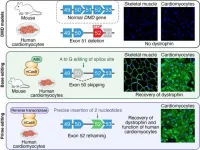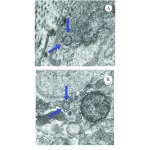(Press-News.org) Wastewater testing is an effective way to identify new cases of COVID-19 in nursing homes and other congregate living settings, and it may be particularly useful for preventing outbreaks in college dormitories, a new University of Virginia study finds.
The research, a collaboration of UVA's School of Medicine and School of Engineering, was led by UVA Health's Amy Mathers, MD. It offers some of the first clear guidance on the most effective methods to perform testing to detect COVID-19 in wastewater.
The researchers evaluated and compared sampling and analysis techniques by testing them within buildings with known numbers of positive cases. They were then able to determine wastewater testing's strengths and limitations as a tool for monitoring COVID-19 in a building population. For example, the technique proved better at detecting initial infections than determining the number of occupants infected or how long they had been infected.
One important answer revealed by the research: Wastewater testing can detect even small numbers of asymptomatic cases, something not previously documented.
"This work could be applied to surveillance in buildings where people live in groups, where transmission may be hard to control but the risk of spread could be high," said Mathers, an infectious disease expert in the School of Medicine's Department of Pathology. "Since we can identify new infections with high sensitivity, it provides an early warning signal of when to test everyone in the building to find and isolate the newly infected persons before an outbreak becomes large."
Wastewater Testing for COVID-19
To evaluate the effectiveness of wastewater testing for detecting COVID-19, Mathers collaborated with Lisa Colosi-Peterson, PhD, an associate professor in UVA Engineering's Department of Engineering Systems and Environment, who connected with Mathers through UVA's Center for Engineering in Medicine. They and their colleagues monitored wastewater from two student dormitory complexes for eight weeks. The researchers found that the wastewater testing caught more than 96% of cases.
One limitation of wastewater testing: It could not distinguish between new infections and virus found in stool from those who had recovered and were no longer contagious. That means the wastewater testing detected both active and former cases. "The inability to distinguish recently infected but no longer contagious persons from new contagious infections within a building is an important finding, as it means that wastewater testing would be best for identifying new cases and isolating individuals in groups without recent infections," Mathers said.
UVA's new research also establishes useful protocols for wastewater testing. In a scientific paper outlining their findings, the researchers describe how they collected and tested the samples, noting that refrigerating the samples on ice adequately preserved them for testing that same day. Institutions that plan to send their samples elsewhere for testing, however, may need to take additional steps to preserve the samples for longer, the researchers note. Cleansers and disinfectants used in the facilities could also degrade the viral RNA over time, they caution.
While the researchers are urging further study, they conclude that wastewater testing holds great promise for detecting and controlling COVID-19 in places where people live in close quarters. "Passive pooled surveillance of wastewater is now serving as an early warning system in many dormitories, barracks and prisons to identify new cases in situations where transmission risk is high," Mathers said. "Applications for wastewater surveillance to inform and control infectious disease transmission will continue to evolve, but it is hard to believe how far and how fast we have come in the last year."
INFORMATION:
Findings Published
The project was a collaborative effort of UVA's School of Medicine, School of Engineering, School of Data Science and UVA Health's Facilities Management. The research team consisted of Colosi-Peterson, Katie E. Barry, Shireen M. Kotay, Michael D. Porter, Melinda D. Poulter, Cameron Ratliff, William Simmons, Limor I. Steinberg, D. Derek Wilson, Rena Morse, Paul Zmick and Mathers.
The researchers have published their findings in the scientific journal Applied and Environmental Microbiology.
The work was supported by a UVA Engineering in Medicine Seed Grant and support from the University Reopening Committee.
To keep up with the latest medical research news from UVA, subscribe to the Making of Medicine blog at http://makingofmedicine.virginia.edu.
SASKATOON - Tepary beans--a high protein legume common to the southwest United States and Mexico--may hold the key to adapting bean crops for the increasingly harsh conditions brought on by a changing climate, according to research led by University of Saskatchewan (USask) and Michigan State University.
In a study just published in Nature Communications, the researchers found that as the mercury rises to 27oC at night--a temperature devastating for current bean crops--specific genes sensitive to heat stress in the tepary bean get activated, protecting the plant. ...
The investigators used machine learning to predict which patients might get worse and not respond positively to being turned onto their front in intensive care units (ICUs) - a technique known as proning that is commonly used in this setting to improve oxygenation of the lungs.
While the AI model was used on a retrospective cohort of patient data collected during the pandemic's first wave, the study demonstrates the ability of AI methods to predict patient outcomes using routine clinical information used by ICU medics.
The researchers say the approach, where each patient's ...
Alexandria, Va., USA -- Carbon dioxide (CO2) is a byproduct of human metabolism and exists in high levels in exhaled air, and is therefore often used as a proxy for indoor air quality. The study "Ventilation Assessment by Carbon Dioxide Levels in Dental Treatment Rooms," published in the Journal of Dental Research (JDR), evaluated CO2 levels in dental operatories and determined the accuracy of using CO2 levels to assess ventilation rate in dental clinics.
Researchers at the University of Rochester, Eastman Institute for Oral Health, N.Y., USA, conducted CO2 concentration and ventilation rate assessments in 10 closed dental treatment rooms with varying ...
Roads can be barriers to wildlife of all sorts, and scientists have studied road impacts on animals ranging from Florida panthers and grizzly bears to box turtles, mice, rattlesnakes and salamanders.
But much less is known about the impact of roads on pollinating insects such as bees and to what extent these structures disrupt insect pollination, which is essential to reproduction in many plant species.
In a paper published online May 10 in the Journal of Applied Ecology, University of Michigan researchers describe how they used fluorescent pigment as an analog for pollen. They applied the luminous pigment to ...
(Boston)--Chronic Obstructive Pulmonary Disease (COPD) is a disease caused by cigarette smoking that reduces lung function and causes difficulty breathing. It is the third leading cause of death worldwide. Current treatments for COPD only affect symptoms, not progression. Identifying who is going to get COPD before they get it is key to figuring out how to intercept the disease at an early stage.
Researchers from Boston University School of Medicine (BUSM) have identified a panel of genes that are active in smokers and ex-smokers who experience faster loss of lung function over time. They believe these genes could be useful to predict which people are most at risk for smoking-related ...
(Boston)--Knee osteoarthritis (OA) is a global health problem. Almost half the adults over the age of 75 have some form of knee OA--one of the leading causes of disability worldwide. Because there is no cure for knee OA, current treatment relies on accurately identifying and staging the disease.
Using an Artificial Intelligence-based approach known as deep learning, researchers from Boston University School of Medicine (BUSM) have now identified a new measure to determine the severity of knee osteoarthritis--named "subchondral bone length" (SBL).
There are only a handful of proven imaging markers of knee OA. Currently, medical imaging tools such as Magnetic ...
DALLAS - April 30, 2021 - UT Southwestern scientists successfully employed a new type of gene therapy to treat mice with Duchenne muscular dystrophy (DMD), uniquely utilizing CRISPR-Cas9-based tools to restore a large section of the dystrophin protein that is missing in many DMD patients. The approach, described online today in the journal Science Advances, could lead to a treatment for DMD and inform the treatment of other inherited diseases.
"Thousands of different mutations causing Duchenne have been identified, but they tend to cluster into certain parts of the dystrophin gene," says study leader END ...
University of Miami Miller School of Medicine researchers are the first to demonstrate that COVID-19 can be present in the penis tissue long after men recover from the virus.
The widespread blood vessel dysfunction, or endothelial dysfunction, that results from the COVID-19 infection could then contribute to erectile dysfunction, or ED, according to the study recently published in the World Journal of Men's Health. Endothelial dysfunction is a condition in which the lining of the small blood vessels fails to perform all of its functions normally. As a result, the tissues ...
Researchers have mapped out the changes in metabolism that occur after a heart attack, publishing their findings today in the open-access eLife journal.
Their study in mice reveals certain genes and metabolic processes that could aid or hinder recovery, and might be good targets for treatments to prevent damage after a heart attack.
"Although some studies have looked at how changes in individual body tissues underlie mechanisms of disease, the crosstalk between different tissues and their dysregulation has not been examined in heart attacks or other cardiovascular-related complications," explains first author Muhammad Arif, a PhD student at KTH Royal ...
Controlling, and mitigating the effects of ice growth is crucial to protect infrastructure, help preserve frozen cells and to enhance texture of frozen foods. An international collaboration of Warwick Scientists working with researchers from Switzerland have used a phage display platform to discover new, small, peptides which function like larger antifreeze proteins. This presents a route to new, easier to synthesise, cryoprotectants.Caption: Using viruses (phage display) to identify the one molecule in a billion (peptide8) that controls the formation of ice. Credit: University of Warwick
Ice binding proteins, which includes antifreeze proteins, are produced by a large range of species from fish, ...




